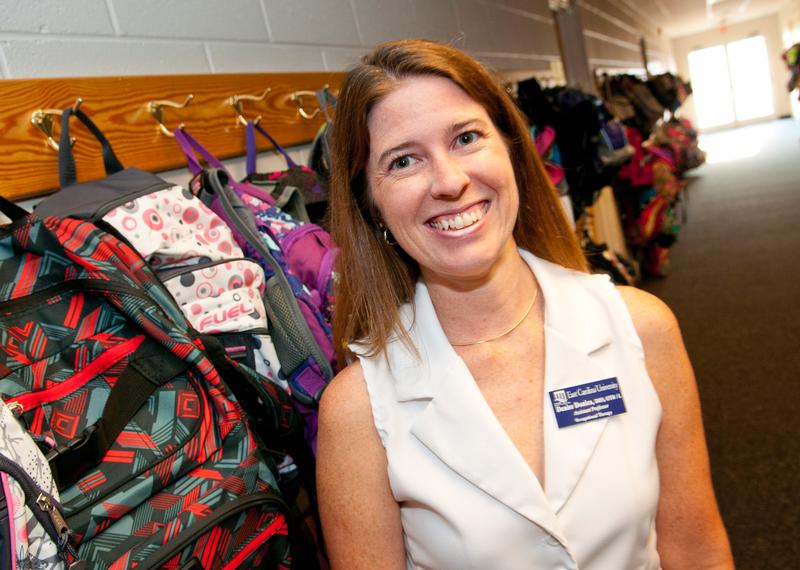Lighten the load
Occupational therapy students teach backpack safety
If a group of Pitt County seventh-graders had their way, eliminating heavy backpacks would be simple.
Get rid of the usually thick science and math books. Make lighter books, or use e-readers for most subjects.
Since traditional textbooks are still the norm, educating students about how much their bags weigh and how to load them was the goal of an East Carolina University-sponsored backpack safety event Sept. 14 at Christ Covenant School in Winterville.
Led by assistant professor Denise Donica and 25 ECU occupational therapy graduate students, the event was a precursor to National School Backpack Awareness Day, which will be held Sept. 21.

Erica Latham, age 12, places her backpack on the scale as (left to right) students Meredith Burke, Katie Apple, and Alison Bailey monitor the results.
The day educates parents, students, teachers and administrators about the health effects heavy or improperly worn backpacks can have on children.
Aching backs and shoulders, tingling arms, weakened muscles and stooped postures are symptoms of wearing a backpack that weighs too much, according to the American Occupational Therapy Association.
As second- through eighth-graders arrived at school, they stepped on the scales. Their book bag was weighed separately, and ECU occupational therapy students calculated the percentage of student-to-backpack weight.
The association recommends that a child’s backpack weigh no more than 15 percent of his or her body weight. For a student weighing 100 pounds, the loaded bag should not weigh more than 15 pounds.
Out of 155 students, 48 were over the 15 percent body weight but the majority of those had rolling backpacks, which is one of the recommended strategies to improve safety when extra weight must be carried between home and school, Donica said.
None of the second-graders had bags over the threshold, but each of the other grades did with two to 15 students per class over the recommendation.
National statistics show that 55 percent of students carry a backpack that is too heavy. Christ Covenant was well below that average at 31 percent. “Overall, I think that is pretty good,” Donica said.
Seventh-grader Hannah Morgan and her friends stood outside humanities teacher Buck Holler’s class, watching the scale with each book bag. Her own bag weighed less than she thought: 8 pounds. “I thought it weighed more,” she said.
The heaviest was a bag weighing 30 pounds, said ECU occupational therapy student Katie Apple of Durham.
Apple and ECU students Meredith Burke of Greensboro and Alison Bailey of Clayton demonstrated for Holler’s class the best way to prepare a backpack by loading heavy items closest to the back and arranging books and materials so they won’t slide around.
Bailey also showed the proper way to wear a backpack, using both straps to distribute weight evenly. Chest straps or waist belts should be worn, too. Wearing a pack slung over one shoulder can cause a child to lean to one side, curving the spine and causing discomfort. “It can cause back problems if you don’t wear it the right way,” Burke told the class.
And, students can hand carry a book or other item if a backpack is too heavy or tightly packed.
“It is important for parents to recognize the weight of the backpack so that they can encourage children in proper wear of the backpack and proper packing,” Donica said. “If parents are aware of proper strategies to help their children, they can advocate for safer techniques for their children.”
###
